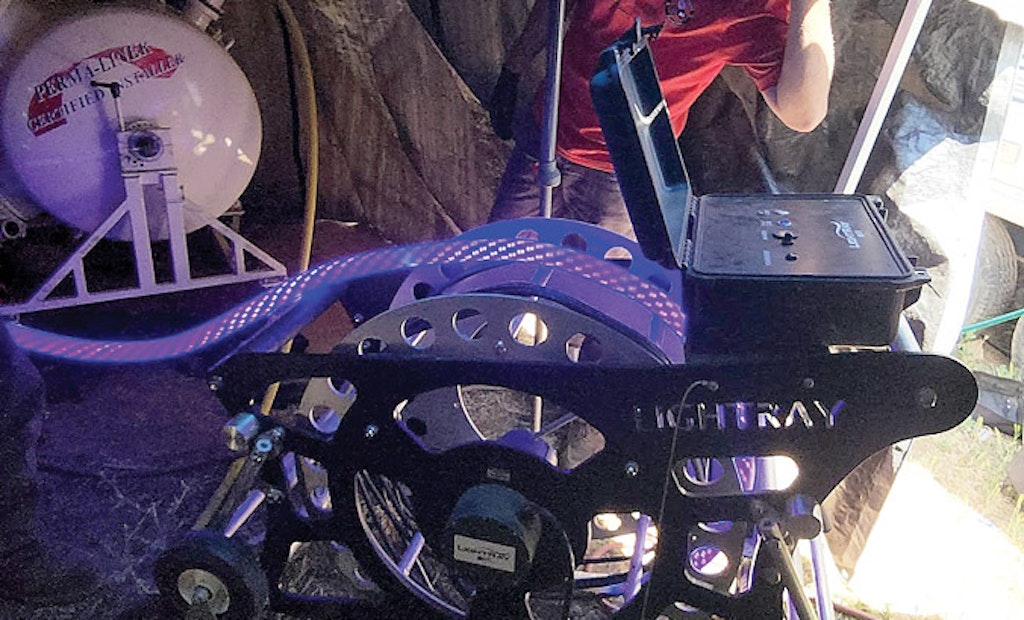
Chris Reynolds uses LightRay technology to cure an 80-foot section of pipe liner in a 4-inch-diameter, cast iron sewer pipe located under a kitchen at a convalescent home. The entire project required lining about 400 feet of failed sewer lines, and Reynolds says the technology enabled his company to finish the job in seven days.
Interested in Relining/Rehab?
Get Relining/Rehab articles, news and videos right in your inbox! Sign up now.
Relining/Rehab + Get AlertsChris Reynolds is a big believer in reinvesting profits into cutting-edge equipment that can improve both his business and better serve the company’s customers.
So when he first heard about the LightRay LRI pipe lining system from Perma-Liner Industries (part of the Waterline Renewal Technologies family of companies), he says he immediately was all in.
“We were the third to buy the system,” says Reynolds, who co-owns Hall’s Plumbing in Woodland, California, with his wife, Jennifer. “I was super excited about it.”
And with good reason. Reynolds says this system, along with other pipe lining technologies, helped him grow the business from 11 employees when the couple bought the company in 2016 to 33 people today. Hall’s Plumbing also runs 27 service vehicles.
The LightRay LRI system, designed to line 3-, 4- and 6-inch-diameter pipelines, ticks off a lot of boxes that are priorities for Reynolds — greater productivity, less downtime for customers, access to new markets, reduction of labor requirements and costs per project, and increased profitability.
In fact, Reynolds says the LightRay LRI technology helped the company land a $1.4 million contract to line 155 10- to 15-foot-long clay pipe sewer laterals in a trailer park, plus another 8,000 feet of 6- to 8-inch clay mainline sewers.
Reynolds says the LRI system also helped him win a lucrative maintenance contract to handle sewer issues for a national chain of dialysis centers with nearly 90 facilities.
Innovative technology
A 50-foot-long “light train” that features a double strand of UV LED lights sets the LightRay technology apart from competitors. The system can “cast” — or cure — up to 150 feet of pipe at a rate of 6.3 feet per minute — no heat or ambient curing needed. The liner and light train can navigate multiple 90-degree bends.
Moreover, the fiberglass liner comes already wetted-out with a non-thermal resin that’s temperature-stable and can be stored for up to nine months with no refrigeration required. That eliminates the time-consuming and tedious chore of mixing resins on site, then wetting-out a liner. It also minimizes the amount of equipment needed on job sites, Reynolds says.
In addition, only the light train can activate the casting process, so it only starts to cast when a contractor is ready to roll, regardless of the temperature, humidity or other factors. That produces more consistent cure times on all jobs, which makes scheduling projects easier, Reynolds notes.
“This technology reduces the cast time from up to several hours to just minutes,” says Reynolds. “It also saves us a substantial amount of labor and provides a wonderful service for our customers, especially our time-sensitive commercial customers. Instead of, say, a convalescent home or a factory going without sewer service for hours, we can reconnect their sewer lines in less than 60 minutes. We can cast (cure) a liner in 10 to 20 minutes, and we no longer have to work during the night on commercial jobs.”
To prep laterals for lining, the company relies on robotic descaling/cutting machines from Picote Solutions, IMS Robotics, Boldan, Schwalm Robotic and Dancutter. For line reinstatements, the company invested in equipment from Hurricane Reinstatement Solutions.
Work faster, less labor
The LightRay technology also significantly improves productivity and reduces labor.
“We make more money because we can do more jobs per day,” Reynolds says.
The company can better compete on project bids because the LRI system requires only two technicians and sometimes an assistant instead of a four-person crew.
“Labor is the largest piece of overhead on a job,” Reynolds says. “But this technology cuts our man-hours by 40 to 50% to around 20 to 24 man-hours for a typical lining job. For example, we’ll be able to shoot up to four laterals per day per crew on that trailer park job, instead of maybe just one or two per crew.”
The system is relatively easy to use, too.
“It’s not any more difficult than traditional cured-in-place lining,” he says. “It’s almost exactly like using an ambient-curing system, just much faster. It’s super simple — you shoot in the liner, insert the light train, press a button and watch it glow for 10 minutes or so until it shuts off automatically. It can even cure that fast underwater.”
Great ROI
Of course, all those advantages come at a price — about $92,000 for the LRI system. Reynolds also invested in the LightRay LR3 system, designed to perform point lining repairs in 3- to 6-inch-diameter pipelines. It cost roughly another $30,000.
But the two lining systems offer a great return on investment, Reynolds says.
“The LRI paid for itself in about seven to eight months,” he says. “As long as you’re busy shooting liners, you can pay off this equipment quickly. You have to get familiar with it and then create a market for it. If people don’t know it exists, they can’t take advantage of it. And if people don’t know you have it, they won’t call you. The key is getting the word out.”
So does Reynolds believe the LightRay technology has lived up to its billing?
“No doubt about it,” he says. “No piece of equipment checks off every box. But when you combine the LRI and the LR3, you check off a majority of them. This technology has opened up a whole other realm of possibilities. The ability to do jobs so much quicker differentiates us in the market from our competitors. And it enables us to do specialty jobs other people in our area can’t do.”





